The Republic of Ireland is an attractive destination for many Healthcare Professionals, including Medical Laboratory Scientists. The country has a good healthcare system, a strong economy, excellent career opportunities, and a high standard of living—a quiet place to live and raise a family if you ask me.
Before I begin, I want to let you know that the terms ‘Medical Laboratory Scientist’ and ‘Medical Scientist’ are used in this article, and they mean the same thing. While it’s called ‘Medical laboratory scientist’ in countries like Australia and Nigeria, it is called ‘Medical Scientist’ in the Republic of Ireland.
Also, note that the Republic of Ireland can be referred to as Ireland in this article. It is completely different from another country called “Northern Ireland,” which is part of the United Kingdom.
That said, let’s begin.
Suppose you are a Medical Laboratory Scientist from any country and want to work in Ireland as a Medical Laboratory Scientist. In that case, this article will guide you through the detailed process of application for your international qualification to be recognised as a Medical Scientist. Without being recognised and registered as a Medical Scientist by CORU, you will not be allowed to practice Medical Lab Science in Ireland.
First, the body that regulates or is responsible for the practice of medical lab science in Ireland is called CORU. CORU also regulates many other professions, such as Radiography and physiotherapy. It’s worth noting that “CORU” is not an acronym. It is a word that means or stands for fair, justice, and proper.
There are two major application steps before you get registered as a medical scientist in Ireland.
1 Application for Recognition (of International Qualification)
2 Application for Registration
This post will address everything you need to know about the first stage, ‘Application for Recognition of International Qualification,’ as well as frequently asked questions.
Table of Contents
- 1 Application for Recognition
- 2 Eligibility for CORU Recognition Application (for international applicants)
- 3 Requirements for CORU Recognition Application
- 4 Recognition Application: Step by step
- 4.1 SECTION 1: Profession Details
- 4.2 SECTION 2: Personal information.
- 4.3 SECTION 3: Eligibility.
- 4.4 SECTION 4: Primary Qualification
- 4.4.1 The initial part of this section is easy and straightforward to fill. So, I will skip it. As you continue down the section, you will notice where you are asked to “ download Verification From Competent Authority Document”
- 4.4.2 Accelerated entry onto any year of this course?
- 4.4.3 Select Measure: ECTS Credits or Hours
- 4.4.4 Number (ECTS Credits or Hours)
- 4.5 Section 5: Post Qualification Employment
- 4.6 Section 6: Post Qualification Education
- 4.7 Section 7: Declaration
- 4.8
- 4.9 Section 8: Documents
- 4.10 Section 9: Checklist. It is very simple. See the attached image below
- 4.11 Section 10: payment/submit application
- 4.12 Processing Timeline
- 4.13 Question and answer
- 4.14 Contributors
Application for Recognition
What does this mean?
When you apply for recognition, you are simply submitting details about you and your qualifications as a Medical Laboratory Scientist to CORU. CORU will examine the information you provided and compare it to the standards used to train Medical Scientists in Ireland. If the standards match or are on the same level, then you will be RECOGNIZED.
If you are recognized, it means your training, qualification, and experience as a medical scientist will be equivalent to those who were trained in Ireland. You will be given a CORU Recognition number and asked to proceed to the next stage of application which is Application for Registration.
However, if your qualifications, training, and/or experience are below the standard set in Ireland, based on the information you provided, you will not be recognised. That is, your Application for Recognition will be unsuccessful.
However, CORU will email you to notify you why you were unsuccessful. The reason could be training deficiencies. One example of a training deficiency is failing to indicate any knowledge of Immunohistochemistry when you fill out your application form. The email will also explain what you are expected to do next.
This next step could be any of the following:
1 Appeal (click here to read about appeal)
2 Adaptation (read more here)
3 Aptitude test (more here)
Nevertheless, let us not dwell on the actions following unsuccessful applications, because I want you to succeed on your first application!!
Now…
Eligibility for CORU Recognition Application (for international applicants)
The first question you should ask, if you are reading this, is, who is qualified to apply? So, before you begin the application process, it’s really very important to ensure that you meet the eligibility criteria set by CORU. To work as a Medical Scientist in Ireland, you will typically need the following:
1 Qualification: Be a graduate Medical Laboratory Scientist from a reputable or recognised institution or school in your country.
2 Registration: Be registered as a Medical Laboratory Scientist with the Medical Laboratory Science Council in your country. In Zimbabwe, this will be ‘The Medical Laboratory and Clinical Scientist Council of Zimbabwe (MLCSCZ), ‘ in United Kingdom, this will be HCPC and in Nigeria, it will be the ‘Medical Laboratory Science Council of Nigeria’(MLSCN). And, of course, you must have a current practice license.
There are other criteria that we will discuss, but these two above are non-negotiable. You MUST have them. There is no way around it, unfortunately. If you have the two above, then you are permitted to continue reading; otherwise, stop now!!
Ah, continue, that was a joke!!
Let us examine what you require to apply for Recognition.
Requirements for CORU Recognition Application
CORU will need the following from you.
- Proof of identity
- Proof of nationality or citizenship
- Proof of your professional competence
- Evidence of your formal qualifications
- Evidence of your professional experience
- Information concerning your training
- Any other information required to complete your application
These proofs or evidence will be contained in some of your documents. So before you begin the actual process of application, you should have the following documents
1 Med lab degree certificate(evidence of your formal qualification)
2 University transcript for your degree certificate
3 Some CPD certificates(3 and above will not hurt!)
4 Evidence of current practising license
5 Proof of English Proficiency (IELTS, TOEFL, letter from your school)
6 International passport (proof of identity and nationality)
There are other requirements, but we will explain them along the line.
So, let’s get started with the main meal!!
Recognition Application: Step by step
First, log on to coru.ie using a computer or laptop. If you use a phone or tablet, it might not look exactly like the Images I will share in this article because I used a desktop!
On a PC or computer, you will see the image below. Click on the “visit site” on Health & Social Care Professionals. This is indicated on the image for clarity. If you are using a phone, you will have to scroll down a bit to see it

Once you open the site, scroll down to Apply for Recognition of International Qualifications and click on it. The image below is for your guidance.
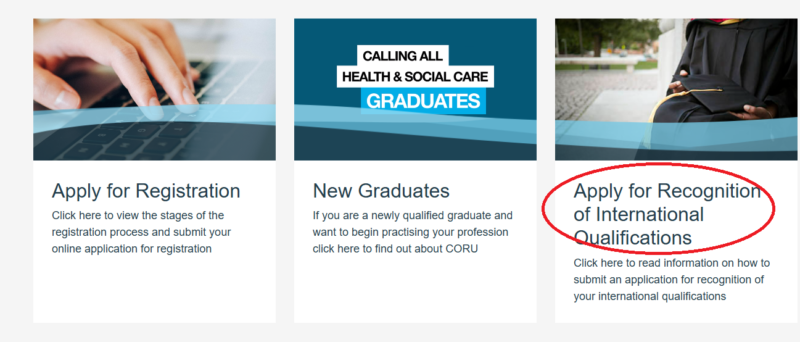
Once you do that, scroll down to the application steps, as shown in the image below.

Steps 1, 2 and 4 are vital information for you to read. When you are done reading them, Click or open step 3, scroll down to the CORU online recognition system, and click on it.
This is shown in the image below

If you click on ‘CORU online recognition system’, scroll down to the last page and check (click) the box next to this sentence – I have read the above Important Data Protection Notice*
See the attached image below for help.

Click the” next” that will appear once you check the box above, and you will see this.
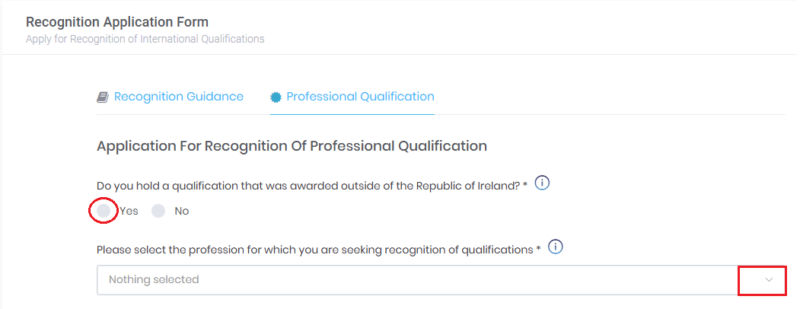
Click yes, as shown in the image above. Click on the dropdown menu under ‘Please select the profession for which you are seeking recognition of qualifications’.
Select Medical Scientist from the list and click on ‘next’
This will take you to a page where you will fill in your personal details, starting with your title. Your title can be Mr., Dr., Miss, Prof., etc.
See below….
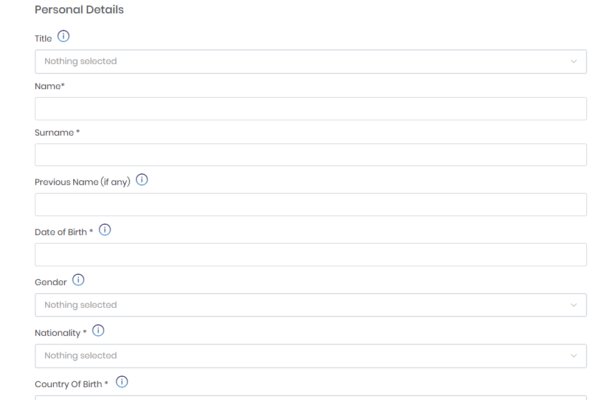
You will provide further information such as your name, surname, nationality, address, email address, password, etc. When you are done with this page and have filled in every piece of information correctly, click next.
However, remember the password you created at this stage is what you will use subsequently to log into your dashboard for this application.
Before you click next, you may be unsure of what to fill in under EU/EEA Citizenship Status * on this page.
If that is the case, choose “OTHER” if you can’t prove any of the other options. Then, manually type in your country, which can be Kenya, Nigeria, Australia, Somalia, etc., and move to the next question.
The other item on this page that might worry you is the Postcode. Do not take it too seriously. If you don’t know your postcode or you don’t have one, type ‘NA’ (not applicable) and move on.
Apart from these two sections, other items are easy to answer. If you finish filling out this page, including creating a password, click next. CORU will send you an email and advise you to click on a link to verify your account details.
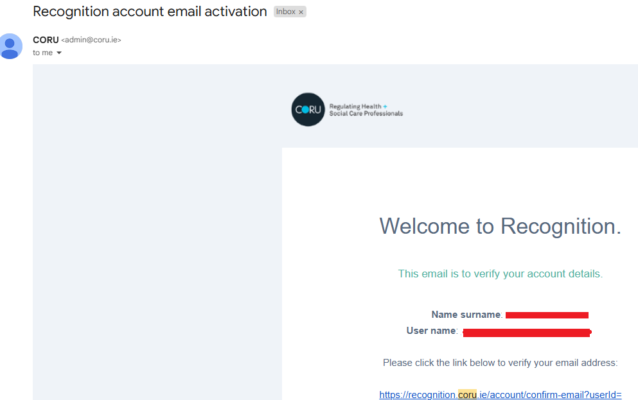
Once you click on the verification link, you will be prompted to log in using the email and password you created earlier.
When you log in, you will be shown a page. Click on the X at the top right corner to remove the wizard(a kind of pop up)
However, If you don’t want to see it pop up again any time you log in, check or click on the box before this sentence- Don’t show me this wizard again. Then click ‘close’ after checking the box. See the image below
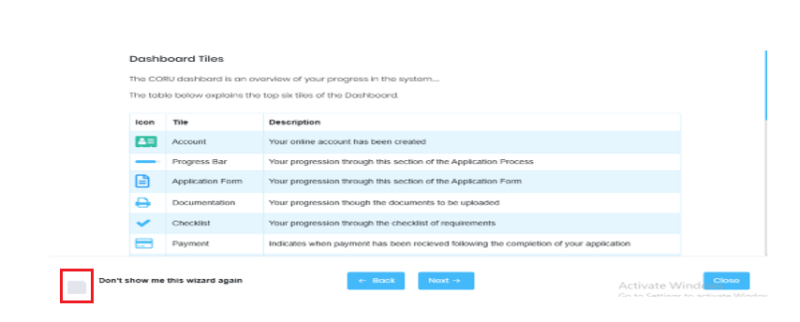
Once this wizard is closed, you will see the image below, which is the Dashboard. The dashboard shows the progress of your application at a glance.
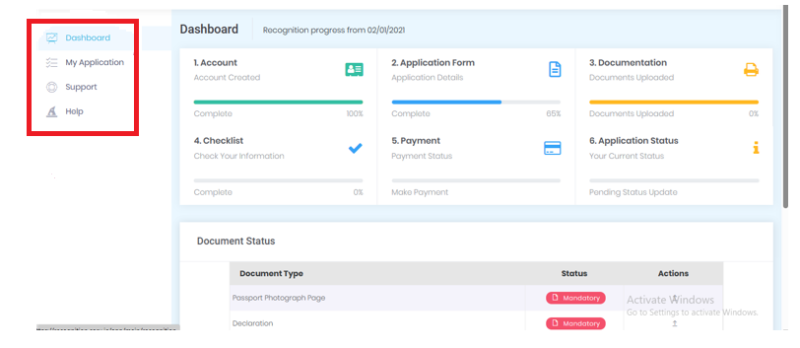
Below the word Dashboard, you will see ‘My application’, located at the left upper corner of the image above. Click on ‘My application’ to start filling out the forms.
The form has 10 sections to fill out, and I will take you through them.
SECTION 1: Profession Details
Here, tick ‘yes’ to the first question and select Medical Scientist in the second question.
SECTION 2: Personal information.
Below this section head, you will see an arrow pointing upwards, which says- ‘Please Upload the Photograph page of your passport or for EU nationals only your National ID card.’
Click on that arrow and upload the data page of your international passport. See the image below

Before you upload your passport, ensure it’s saved as a PDF file, as instructed. Do not upload it as a JPEG!
Every other field in this section is easy to fill out or has been prepopulated with the information you provided earlier. Cross-check that the information is correct, then move to the next section.
SECTION 3: Eligibility.
Here, select your country from the list, click ‘yes’ and then click on the ‘arrow’ to upload your current license as a medical lab scientist. The instruction that says, ‘Please provide certified documentary evidence (in English)’ refers to your license.
Note that the license you will upload is certified by a notary public, commissioner of oaths, etc. as instructed by CORU. See the image below for help.

As you continue to fill out the form under this section, you will encounter a question asking you to provide proof of eligibility to be registered from this Registration body.

This is not a license. It is your professional registration with your professional council after you graduate from the university. It contains your Registration Number, which comes in the form of a letter. If you are a Nigerian, you will receive this after completing your internship.
The document certifies you as a registered medical laboratory scientist, as seen in the image below(for Nigerians)

Other questions in this section are easy to answer.
SECTION 4: Primary Qualification
The initial part of this section is easy and straightforward to fill. So, I will skip it. As you continue down the section, you will notice where you are asked to “ download Verification From Competent Authority Document”

When you download this form, you will notice CORU has questions they are asking your professional council to answer on your behalf. They (your council or regulator) will send the response directly to them(CORU), not you.
Send this form to your council by email or physical means.
This means that if you owe your council, they will not respond to CORU until you clear your debts. This is where the LETTER OF GOOD STANDING from your council comes in(for Nigerians).
So, at this stage, it’s assumed you do not owe your council any penny!!
However, some countries may still charge you before they respond to CORU, whether you were owing or not.
If you are a Nigerian, you will pay around 40,000 Naira before this letter of good standing is written for you. So you will attach the receipt of the 40k to the downloaded form (Verification From Competent Authority Document) and submit both to the Medical Laboratory Science Council of Nigeria. (MLSCN)
Let’s continue. As you go further down in section 4, you will encounter a part that some candidates are confused about how to fill out. I will explain from the image below.

Accelerated entry onto any year of this course?
Here, CORU is asking if you jumped class! For instance, if you studied microbiology first and then started a Medical Lab Science course in the second year instead of the first year, then you had accelerated entry. In Nigeria, this is called Direct Entry (to University)
Choose ‘yes’ if you had an accelerated entry. This means you will also provide a transcript of the certificate that qualified you for an accelerated entry. In Nigeria, this is usually an OND, HND, or BSc certificate.
However, if you started from year one, choose ‘No’.
Choose relevant qualifications framework(FW)
The options are:
- European Union FW
- Irish FW
- Not Applicable
- United Kingdom FW
To understand what a qualification framework is, click here to see the Irish National Qualification Framework(NQF) and compare your training with it.
However, if you are confused about what to choose, or you don’t know your qualification framework, choose ‘Not Applicable’.
Select Measure: ECTS Credits or Hours
Select what applies to you. If you are a Nigerian, select CREDITS.
Number (ECTS Credits or Hours)
Here, get the total credit (units) loads from your first year to the final year and input them there. You can easily get this information from your transcript if you have it. The image below shows the credit units to add for the first semester and first year from a Nigerian University.
Since each year of study has two semesters, you will add a total of ten semesters’ unit loads for a five-year program. The image below is from a student’s transcript.

And that is it!!
If you continue, you will meet with this…

Primary qualification for recognition – certificate of award…this is your degree certificate from the university you graduated from. You will click the upward arrow sign under ‘Actions’ to upload it. This document is certified by a Notary public or Commissioner of oaths etc. as instructed by CORU.
Primary qualification for recognition – course curriculum document….this document is prepared by your school through your department. Once you get it from your school, you upload it here. It is your responsibility to contact your department to prepare this document for you. This document (curriculum) does not need to be certified by a Notary public or commissioner of oaths, etc.
Primary qualification for recognition – official transcript…here, you will have to make application to your school to get your transcript. Often, it is not free. When you get it, you upload it here by clicking the upward arrow sign. This transcript does not need to be certified by a Notary public or Commissioner of oaths, etc.
Qualification (download from form)…..Here, you first download the form by clicking the downward arrow sign shown in a blue circle on the image above. This form will be taken to your school, where you graduated from as a medical lab scientist, via your department, and they will verify you. Once you are verified, you will return to this page and upload the verified form using the upward arrow sign shown in a black box on the image above. Verification here means your school signing and stamping the document.
Section 4.1 of the form talks about research; every graduate of Medical Laboratory Science did project research in their final year, which is what this section asks you about. See the image below for clarification.
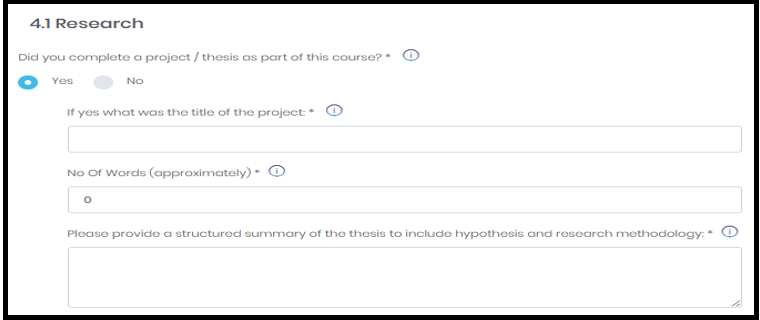
Do you still remember your project topic or title? What was the total word count of the project? This is going to be tough if you graduated many years ago and do not have a soft copy of it, but I will leave you to deal with it!!
However, the average word count of final-year project work for medical laboratory scientists in Nigeria is about 10,000 words.
The next question says: Please provide a structured summary of the thesis to include hypothesis & research methodology.
You will copy and paste your abstract into that column.
But make sure your abstract actually captures your work. If not, rewrite it afresh to capture everything you need to write. CORU does not overlook anything.
The next is:
4.2 Placements
Placement is all about posting or simply clinical posting in teaching hospitals or any hospital your school uses for your training.
Some schools start clinical posting from 3rd year, so under this section, you will fill 3 different forms for 3rd year, 4th year and 5th year. If your clinical posting starts from first year, you will have 5 forms to fill-1st, 2nd, 3rd, 4th and 5th year.
To start this section, click on the ‘+’ sign at the bottom right of the box shown in the image below.

When you click the plus sign and the form opens, the first item to fill in is NAME, which is the name of the hospital where you did the clinical posting.
The most important part of this form is the section for Main Duties. If you do not fill this place out properly, you may be denied recognition due to a deficiency in clinical posting.
So, take your time and fill in your duties during clinical posting. Fortunately, this information is already in your logbook. That is if you filled out your logbook religiously during posting.
If you copy and paste what you learnt from the 3rd year into your 4th and 5th year, it shows there is no progression in your learning, and you may need to clarify this to CORU because it will not be overlooked.
The idea is that it’s not the same thing that you learned in 3rd, 4th and 5th year. Therefore, your postings in the 3rd, 4th and 5th years should show progressive learning experience, from simple laboratory procedures in the 3rd year to complex ones in the 5th year.
Remember, in each posting year, for instance, 3rd year, you move across all the specialties. This means you would have to summarise the main duties in all the units in this form.
There is a part of this form that you may find confusing to fill. I will explain with the image below.

Supervisor Name
Your teaching hospital might have ONE scientist in charge of students in clinical posting. This particular scientist is your supervisor and his or her name is what you will write under ‘supervisor’s name’. Your supervisor position can be a chief, assistant director, deputy director, etc.; fill it there.
Supervisor Position
Remember, your supervisor MUST be a medical lab scientist. CORU will not accept anything else.
Supervision frequency
You might have issues with the question-supervision frequency. Because of the number of students on clinical posting in some hospitals, in some countries, the work of the supervisor is usually delegated to scientists you work with on a daily basis, making your supervision frequency daily.
If you have a different arrangement in your facility, fill in the information accordingly.
Total Number of hours
For the total number of hours for your posting, you would be able to calculate it. You should be able to get this information from your course curriculum, which states the total number of hours for your clinical postings in the first and second semesters. Adding the two semesters will give you the total number of hours for clinical placement for each year or level.
To hint at what is obtainable in Ireland for a Medical Scientist, the total standard hours required is 1,000 hours minimum. This is based on 30 weeks of posting (placement). This translates to 6 weeks of posting in each of the 5 specialties (Hematology, Microbiology, Histopathology, Blood transfusion and Chemical pathology). The interpretation is that you would have a minimum of 200 hours of clinical exposure( posting/placement) in each specialty. That is, 200 hours times 5 specialties equals 1,000 hours. If you have more hours of posting, that is fine; if you have less than the minimum, then there will be an issue!!
More often than not, it’s more than 1000 hours of posting for medical laboratory scientists trained in Nigeria.
Before I forget, some hospitals may incorporate Immunology under Microbiology, some under Chemical pathology, and some as stand-alone units. Whichever way, your posting in Immunology adds to your exposure time rather than reduces it.
Placement mode
Placement mode (posting method) is usually full time.
When you finish filling out the form, click on the save button. Click the plus sign again, fill the form, save, click again the plus sign, fill and save. That would be for three years (3rd year, 4th year and 5th year, respectively).
After this, you will see an image like this below.

From the image above, you will see downward arrows under ‘Actions’. Click on the arrows to download the forms for each year.
These forms will be taken to the hospital(s) where you did your clinical posting so they can verify it by signing and stamping the form.
Once this is done, go back and upload them using the upward arrows under the ‘Actions’ column. When you do this, you will see this below…

The next section to fill is about Internships.
Internship

Click on the plus sign to fill out the internship form. When you finish filling out the form and click save, you will see this image below.

Then, click on the downward arrow under ‘Actions’ to download the internship form. Take this downloaded form to where you did your internship so they can certify you by signing and stamping the form. You can, of course, send the form through email so it can be verified and returned to you through email, too.
After this, go back and upload the certified internship form by clicking the upward arrow under ‘Actions’. You will see

The next item is about secondary qualifications. Some people may have had another degree, such as Microbiology, Botany, Biochemistry, OND/HND, etc., before starting the BMLS degree program. This section is where you will indicate it if you wish.

If you don’t have a secondary qualification, move on to the next section.
Section 5: Post Qualification Employment

It is assumed that at the point of making this application, you are currently working and should be able to provide the official email address of your employer. If you are not working, you will provide the official email address of your most recent (last) employer.
Bear in mind that any gap in your employment history must be explained.
For instance, if you worked from January 2019 to December 2020, and your next employment history begins by January 2022 till date, you must explain what happened in 2021. It could be sick leave, maternity leave, short course, or loss of job. If you do not explain this before sending in your application, CORU will email you seeking clarification.
This will, in turn, delay your application as CORU does not sit every day to review applications.
You should also be able to mention the equipment you have used in the course of your practice. If you fail to do so, you might receive an email from CORU asking you to elaborate on this. You cannot be working as a medical laboratory Scientist and not be using equipment in the lab.
If you do not have work experience yet, perhaps you have just graduated, you will choose ‘no’ under this section, and your application will be determined solely based on your training and clinical posting (placement).
Remember, if you have worked in three different hospitals for one year each in 2021, 2022, and 2023, this means you will start filling out your post-qualification experience form with the hospital you are working with in 2023, followed by the one in 2022 and lastly the hospital you worked in 2021 in that order.
If you have worked in one hospital, then that makes it easier for you. Provide information for that particular hospital, and that’s all.
To start this journey, click the plus sign in the image below.

This form has three pages. The first page is ‘Employer Details’. When you finish this first page, click next to fill out page 2, which is “Employment Details.” Then click next again to fill out page 3, which is about “Employment information.”
When you are done doing this, you will see this.

The next thing to do is to use the downward arrow under ‘Actions’ to download the forms you have filled for each hospitals you worked.
From the image above, it showed only two hospitals: JCOLAB and JCOLaboratories. It is possible you have worked in 3 hospitals or one. The number of form you will download here depends on the number of work places you worked and filled.
When you download the forms, you take them to where you have worked. They will verify it by signing and stamping on the forms.
The person who verifies it will send a copy directly to CORU and also send you a copy. It is your own verified copy that you will go back and upload using the upward arrow as shown above.
By implication, the person who will verify this document will not send his copy to CORU until you have submitted your application.
If they send it before you submit your application, CORU does not know you and will not be able to link it to your application.
So when you finish uploading the verified copies from places you have worked, it will look like this

The next section is:
Section 6: Post Qualification Education

This is where the issue of Continuous Professional Development (CPD) comes in. If you choose a ‘No’ option, there will be no further action in this section.
If you choose a ‘yes’, you will have to fill form concerning the CPD, save, then download the form. This form will be verified by the CPD provider before you re-upload it using the upward arrow as usual.
You may be thinking, is it not better to choose ‘No’ to avoid stressing yourself with all the downloading, verifying and re-uploading.
Well, CPD is usually one of the requirements for license renewal in almost all medical professions. It will be odd if you claim not to have one and you have been practicing.
CORU might write you to explain why you don’t have a proof of CPD. This will further delay your application process. So avoid anything that could potentially delay your application.
If you choose ‘yes’, you will see this dialogue below

The question becomes, where do you fill, education or training? Confusing, right?
There is no reason to over think it, if you have a training workshop you attended, or online CPD programs you participated in, you can enter the information under Training.
If you have done your MSc or PGD program, you can enter the details of what you have under Education. When you finish, and save what you have filled, you will see
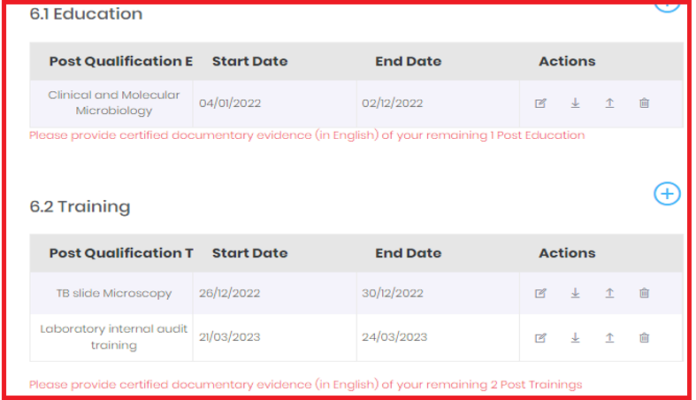
The next step is to download these forms you filled. You do this by clicking the downward arrows under “Actions” as shown in the image above.
The downloaded forms are taken to those who provided the training or education you claimed to verify them. They verify by signing and stamping the documents. You do not go to court or to a lawyer to verify them.
After they are verified, you upload them back using the upward arrows as shown in the image above under “Actions”
When you do that, you will see this

The next section….
Section 7: Declaration
You are required to read this and sign it. This is the almighty “terms and condition”. Without your signing it, your application will never be processed.

The instruction is simple. Download this declaration form using the downward arrow by the right hand side under “Actions”. Sign it and then re-upload using the upward sign by the left hand side of the image above.
After that, you will see

The next section is
Section 8: Documents
This section is for you to check if you have uploaded the entire required documents. If there is any missing document yet to be uploaded, you will notice it here and do the needful.
This a samples of what you would expect to see
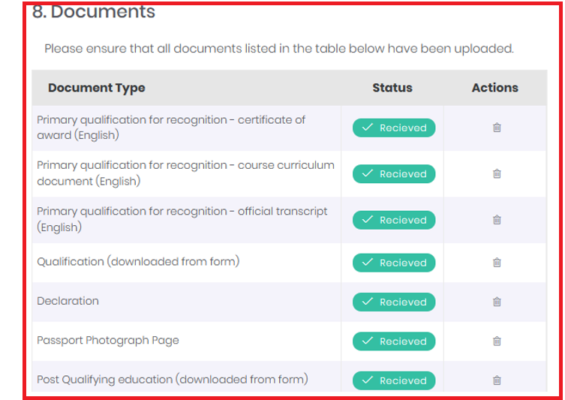
Any document not uploaded will not show “Received” status.
The next section is
Section 9: Checklist. It is very simple. See the attached image below

So you must check (click) on the two grey boxes on the left side of the image above. After that, you proceed to subsections called “Processing Timelines” and “Documents uploaded”
and also check (click) the similar grey boxes as well.
The last section is:
Section 10: payment/submit application

Simple! Submit and pay!!
What is next?
Processing Timeline
According to CORU on https://recognition.coru.ie/account/guidance, the sketch below explains what happens after you pay and submit your application.

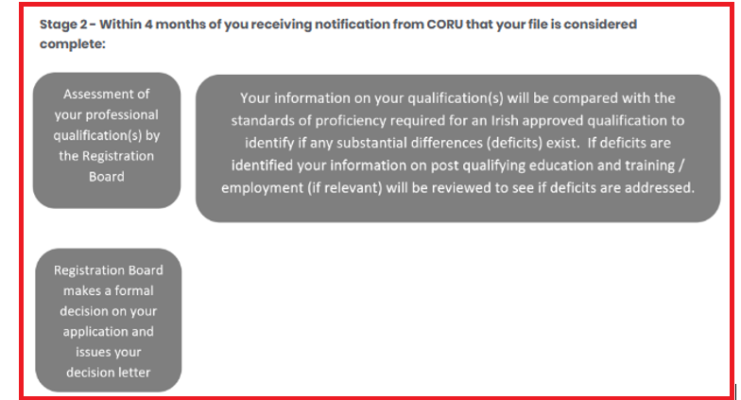
Question and answer
1 What is next after submission and payment?
A: Within 7 days, CORU will provide email confirmation to acknowledge the receipt of your application. If you do not receive any response within 7 days, get in touch with CORU at recognition@coru.ie
2 What happens after CORU confirms they have received my application?
A: CORU will check your documents to know if they are complete and reply you within one month. If your documents are complete, they will proceed to evaluate you and within 4 months, get back to you with the outcome. If your documents are incomplete, they will inform you to complete it.
Contributors
Shadrack ASamota……………………….Medical Scientist
Manufa Kuzuzanya……………………….Medical Scientist
Orisakwe Onyekachi……………………..Medical Scientist
Chukwuebuka Harrison Aninze……… Medical Scientist


This is a great piece. Thanks for putting this down
I am glad you like it.